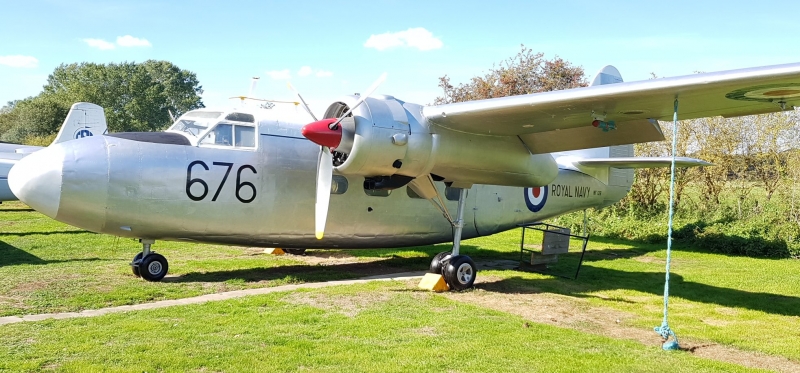HUNTING PERCIVAL SEA PRINCE T.1
The Royal Navy was the first of the Services to order a military version of the Percival Prince civil feeder liner and executive transport and used three variants. It first appeared in 1948, three years before the Pembroke aircraft of the Royal Air Force. The first production version in 1950 – the C.1 – was equipped for special communications duties and the next three C.1s for naval personnel transport, including one as an “Admiral’s Barge” for VIP transport. The second production version in 1951was the T.1with a lengthened nose to house radar equipment, and met the Royal Navy’s requirement for a “flying classroom”. The fuselage was fitted out to accommodate three pupils and a comprehensive range of wireless and radar equipment for training observers in navigation and the techniques of anti-submarine warfare. For this purpose it was equipped with two bomb bays and racks underwing for practice bombs or sonar buoys. A total of 41 were built. The final version was the C.2 in 1953, a communications version of the T.1, and three were built.
WF128
This aircraft was delivered to RNAY Stretton on 5/3/52 and stored. By 7/58 it was serving as 676/CU with 750 Squadron, the Naval Observer & Air Signal School at RNAS Culdrose. In mid-1959, the squadron moved to Hal Far, Malta, where it became 676/HF, and later 673/HF. The squadron returned to Lossiemouth in the UK in 7/65 where the aircraft was seen as 638/LM in 1/66. It was delivered to RNAY Sydenham in 10/69 and had its mainplanes re-sparred; it was also resprayed in 5/70 and left without markings. In 6/70 it was delivered to Lossiemouth coded 638/LM again, then returned to Sydenham – when seen on 24/9/70 it no longer had a code. It returned to Lossiemouth four days later with the code 638/LM, which it retained until the squadron moved to Culdrose on 26/9/72 when it was recoded 570/CU. Later it returned to Sydenham and on 10/9/73 was transferred to BAC at Hurn. On 11/1/74 it was delivered to A&AEE Boscombe Down and stayed until returning to Sydenham on 18/2/74, using call-sign “Evergreen 36” and carrying no markings. It returned to Hurn on 28/7/75 and was used as a trials aircraft for testing a series of modifications. It was returned to Sydenham in 9/76 for storage on the announcement that the Royal Navy was to operate the Jetstream. The aircraft was delivered to 5MU at Kemble on 4/11/78 where it was stored until going by road to RAF Honington on 5/2/79, and here allocated the maintenance airframe serial 8611M. Around 3/80, the RAF camouflaged it dark green overall with no markings. The aircraft was offered for disposal in 1981 and acquired by the museum in the September.
TECHNICAL INFORMATION
- Year Built: 1952
- Manufacturer: Hunting Percival Provost
- Purpose: Navigation and Anti-Submarine Trainer
- Crew: 2
- Engines: Two 550hp Alvis Leonides 125
- Armament: Underwing points for practice bombs, buoys, etc.
- Maximum Speed: 223mph (358kph)
- Service Ceiling: 22,000ft (6,705m)
- Range: 400 Nautical Miles
- Wing Span: 56ft (17m)
- Length: 46ft 4in (14.1m)
- Height: 16ft 1in (4.9m)
- Gross Weight: 11,850lb (5,375kg)






